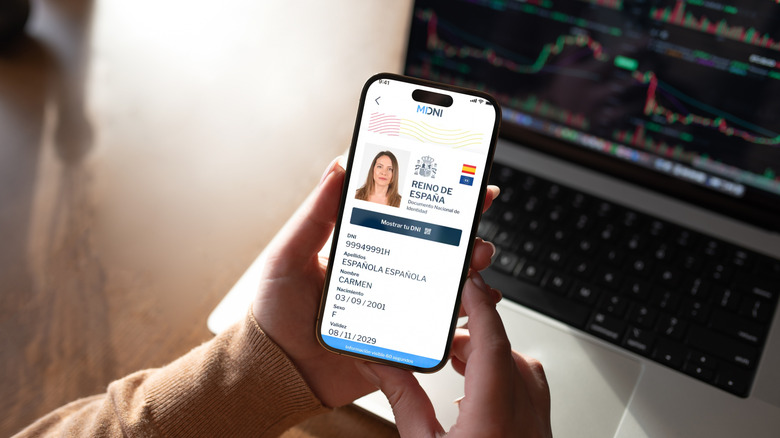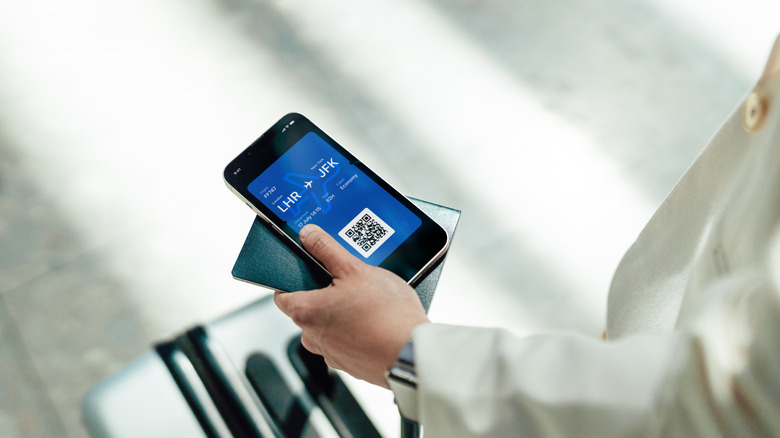What Tourists Need To Know About The Convenient Form Of ID TSA Accepts In Some States
Imagine arriving at the airport at what feels like the crack of dawn, your mind voraciously replaying the months of preparation for this long-awaited vacation to Kauai's 'secret' beach only accessible by hiking. You've mapped out the details, from the hotels to the excursions, and even set multiple alarms to ensure your ride beats the normal traffic rush. As you join the line for security, excitement builds, only to realize you left your wallet at home. Your drivers license, essential for passing the TSA checkpoint, is out of reach. A simple mistake can turn an already anxiety-evoking experience into a logistical nightmare, especially with stricter rules in place since the REAL ID Act's full enforcement or Europe's new entry-exit system.
Air travel demands have evolved, and thankfully so have technology aimed at easing them. Smartphones now hold an assortment of everyday essentials digitally: event tickets, credit cards, medical prescriptions, and even boarding passes that eliminate the need for extra paper or plastic print outs. Adding to this list is the digital mobile ID, a state issued electronic version of your drivers license or identification card that is accepted by the Transportation Security Administration (TSA) at specially equipped checkpoints. This innovation allows travelers in participating states to verify their identity with their phone.
The advantages are practical for tourists and travelers. It streamlines the process with a quick tap or scan, potentially cutting wait times during busy seasons like holidays without more additional airport screenings. Privacy is improved since only necessary information is shared and not a person's entire ID card. As more states join, this could potentially transform how Americans and tourists visiting travel and navigate airports.
Understanding and setting up the digital mobile ID
The digital mobile ID operates as a secure encrypted copy of your physical state-issued driver's license or ID card and is stored on your smartphone in an app for electronic verification. At TSA checkpoints with Credential Authentication Technology (CAT-2) readers, travelers can tap their device or scan a QR code to verify their identity. A biometric camera may take a voluntary photo for facial comparison to confirm identity, with TSA stating the image is deleted immediately afterwards. This ensures TSA agents only see the information that is needed and no other passenger information.
Opting in is voluntary, and starts with confirming if your are eligible. As of August 2025, the participating states are: Arizona, Arkansas, California, Colorado, Georgia, Hawaii, Iowa, Louisiana, Maryland, Montana, New Mexico, New York, Ohio, Utah, Virginia, and West Virginia. To check if your state or your visiting state is participating, review the TSA's updated list. This website includes links to state DMV sites for more specifics and which digital ID qualifies.
Setup varies by state and platform but is generally user-friendly. Start with downloading an app like Apple Wallet, Google Wallet, or state specific apps like California's DMV Wallet or New York's NY MiD. Typically, you'll need to scan your physical ID both front and back, take a verification selfie, and submit for approval. The process might also require additional ID proof like a passport. It is recommended to begin and complete this process well in advance of your travel, as verification might take time. Once accepted and ready, travelers can use it at over 250 CAT-2 equipped airports nationwide.
Enhancing security, traveler experience, and addressing concerns
Digital mobile IDs are meant to strengthen airport security by addressing flaws in physical documents, such as susceptibility to counterfeiting, loss, or theft. The encrypted design and selective disclosure of the digital ID makes tampering more difficult, and allows TSA to verify identities more reliably. This is meant to support larger aviation goals like automating screenings to minimize errors and contact points with travelers in order to foster a safer and faster experience through airports as passenger volumes rise.
For the tourist experience, it hopes to deliver efficiency through faster verifications that equate to shorter screening lines, which benefits tourists and visitors with tight connections or families that are managing gear and little ones. Contactless use aligns with more health conscious habits, especially after the COVID-19 pandemic, and as adoption expands to all American airports, it could create more seamless journeys. However, TSA does recommend that tourists travel with a physical ID as the program is adopted.
Even though TSA notes this will not allow TSA to build a national data base of identity information, concerns for the program exist. Privacy risks include potential tracking by ID issuers or data exposure in breaches, despite TSA's assurances of no storage or surveillance. Lawmakers highlight the dangers of big business control in systems that enable centralized monitoring without transparent safeguards. Low adoption in some areas might reflect these worries, alongside the fears of evolving into mandatory tools without congressional oversight.


